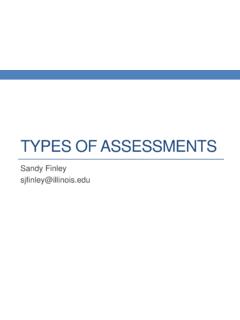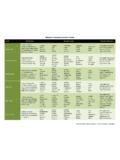Transcription of Field Book for Describing and Sampling Soils - USDA
1 Field book for Describing and Sampling Soils Version National soil Survey Center Natural Resources Conservation Service Department of Agriculture September 2012. ACKNOWLEDGMENTS. The science and knowledge in this document are distilled from the collective experience of thousands of dedicated soil scientists during the more than 100 years of the National Cooperative soil Survey (NCSS) program. A special thanks is due to these largely unknown stewards of the natural resources of this nation. Special thanks and recognition are extended to those who contributed extensively to the preparation and production of this book : the soil scientists from the NRCS and NCSS cooperators who reviewed and improved it; Tammy Umholtz for document preparation and graphics; and the NRCS soil Science Division for funding it. Proper citation for this document is: Schoeneberger, , Wysocki, Benham, and soil Survey Staff. 2012. Field book for Describing and Sampling Soils , Version Natural Resources Conservation Service, National soil Survey Center, Lincoln, NE.
2 Cover Photo: A polygenetic Calcidic Argiustoll with an A, Bt, Bk, 2BC, 2C horizon sequence. This soil formed in Peoria Loess that blankets the fluvial Ash Hollow Formation of the Ogallala Group. It occurs in an undulating area of the Cheyenne Tablelands in northern Banner County, Nebraska. The scale is in meters. (Photo by Doug Wysocki, NRCS, Lincoln, NE, June 2011.). Trade names are used solely to provide specific information. Mention of a trade name does not constitute a guarantee of the product by the Department of Agriculture nor does it imply endorsement by the Department or the Natural Resources Conservation Service over comparable products that are not named. The Department of Agriculture ( usda ) prohibits discrimination in all its programs and activities on the basis of race, color, national origin, age, disability, and where applicable, sex (including gender identity and expression), marital status, familial status, parental status, religion, sexual orientation, political beliefs, genetic information, reprisal, or because all or part of an individual's income is derived from any public assistance program.
3 (Not all prohibited bases apply to all programs.) Persons with disabilities who require alternative means for communication of program information (Braille, large print, audiotape, etc.) should contact usda 's TARGET Center at (202). 720-2600 (voice and TDD). To file a complaint of discrimination, write to: usda , Assistant Secretary for Civil Rights, Office of the Assistant Secretary for Civil Rights, 1400 Independence Avenue, , Stop 9410, Washington, 20250-9410, or call toll-free at (866) 632-9992 (English) or (800) 877-8339. (TDD) or (866) 377-8642 (English Federal-relay) or (800) 845-6136 (Spanish Federal-relay). usda is an equal opportunity provider and employer. usda -NRCS i September 2012. FOREWORD. Purpose: The following instructions, definitions, concepts, and codes are a Field guide for making or reading soil descriptions and Sampling Soils as presently practiced in the USA. (Note: References cited in the Foreword are listed at the end of Chapter 1 [p.)]
4 1 31].). Background: soil description methodology was developed by soil scientists throughout the entire course of the soil survey. The usda published small instruction booklets for Field parties, including soil descriptions, in 1902 1904, 1906, and 1914. The first usda guide for soil horizon identification and description was released in 1937 (Bureau of Chemistry and Soils , 1937). Dr. Roy Simonson and others later summarized and revised this information ( soil Survey Staff, 1951; soil Survey Staff, 1962). Brief color- book inserts with shorthand notation were released by the soil Conservation Service (Spartanburg, SC, 1961;. Western Technical Center, Portland, OR, 1974). Previous Field Books were released in 1998 (Schoeneberger et al.) and 2002. (Schoeneberger et al.). This is an updated Field book version that summarizes current knowledge , includes updates since 2002, and reflects changes in source documents. Standards: This Field book summarizes and updates current National Cooperative soil Survey conventions for Describing Soils ( soil Survey Manual [ soil Survey Division Staff, 1993]; National soil Survey Handbook [ soil Survey Staff, 2012d]; National soil Information System (NASIS), release [ soil Survey Staff, 2012c]; and NASIS Data Dictionary [ soil Survey Staff, 2012a]).
5 Some content is an abbreviation of primary sources. Regarding Pedon PC and NASIS: The Field book is a current, practical soil description guide for the soil science community. It is not a guide on How To Use Pedon PC or NASIS. Differences and linkages between soil science conventions, Pedon PC, NASIS, and older systems are shown, where reasonable to do so, as an aid for interpreting and converting archived data. Standard procedures and terms for Describing Soils have changed and increased in recent years ( , redoximorphic features). Coincident with these changes has been the development and use of computer databases to store soil descriptions and associated information. The nature of databases, for better or worse, requires consistent and correct . use of terms. Sources: This Field book draws from several primary sources: The soil Survey Manual ( soil Survey Division Staff, 1993) and the National soil Survey Handbook (NSSH), Parts 618 and 629 ( soil usda -NRCS ii September 2012.)
6 Survey Staff, 2012d). Other important sources are footnoted throughout to give appropriate credit and encourage in-depth information review. Other material is unique to this book . Brevity: In a Field book , brevity is efficiency. Despite this book 's apparent length, the criteria, definitions, and concepts are condensed. We urge users to review the comprehensive information in original sources to avoid errors resulting from our brevity. Measurement Units: For soil description, metric units are the scientific standard. Both NASIS and Pedon PC use metric units. Format: The Site Description and Profile Description sections generally follow conventional profile description format and sequence ( , SCS-Form 232, December 1984). Some descriptors are arranged in a sequence more compatible with Field description rather than data entry ( , Horizon Boundary is next to Horizon Depth, rather than at the end). The sequence followed differs somewhat from and does not supersede convention for writing formal soil descriptions in soil survey reports or Official soil Series Descriptions ( , National soil Survey Handbook, Part 614; soil Survey Staff, 2012d).
7 Codes: Shorthand notation is listed in the Code column for some descriptors. Long-standing conventional codes are retained because of widespread recognition. Some recent codes have been changed to make them more logical. Some data elements have different codes in various systems ( , conventional [Conv.] vs. NASIS vs. Pedon PC), and several columns may be shown to facilitate conversions. If only one code column is shown, it can be assumed that the conventional, NASIS, and Pedon PC codes are all the same. Standard Terms vs. Creativity: Describe and record what you observe. Choice lists in this document are a minimal set of descriptors. Use additional descriptors, notes, and sketches to record pertinent information and/or features if no data element or choice list entry exists. Record such information as free-hand notes under Miscellaneous Field Notes. Changes: soil science is an evolving Field . Changes to this Field book should and will occur. Please send comments or suggestions to the Director, National soil Survey Center, usda - NRCS; 100 Centennial Mall North, Rm.
8 152; Lincoln, NE 68508- 3866. usda -NRCS iii September 2012. TABLE OF CONTENTS. ACKNOWLEDGMENTS.. i FOREWORD .. ii SITE DESCRIPTION.. 1 1. Describer Name(s) .. 1 1. Date.. 1 1. Climate .. 1 1. (Weather Conditions, Air Temperature, soil Temperature [ soil Temperature, soil Temperature Depth]). Location.. 1 2. (Latitude, Longitude, Geodetic Datum). Topographic Quadrangle.. 1 2. soil Survey Site Identification Number (Site ID) .. 1 2. County FIPS Code .. 1 3. MLRA.. 1 3. Transects.. 1 3. (Transect ID, Stop Number, Interval). Series or Component Name.. 1 4. (Map Unit Symbol, Photo #). Geomorphic Information.. 1 4. Physiographic Location.. 1 4. (Physiographic Division, Physiographic Province, Physiographic Section, State Physiographic Area, Local Physiographic/Geographic Name). Geomorphic Description.. 1 4. (Landscape, Landform, Microfeature, Anthropogenic Feature). Surface Morphometry .. 1 5. (Elevation, Slope Aspect, Slope Gradient, Slope Complexity, Relative Slope Segment Position, Slope Shape, Hillslope - Profile Position, Geomorphic Components [Hills, Terraces and Stepped Landforms, Mountains, Flat Plains], Microrelief, Drainage Pattern).
9 Water Status.. 1 11. Drainage .. 1 11. Flooding.. 1 13. (Frequency, Duration, Months). Ponding.. 1 14. (Frequency, Depth, Duration). ( soil ) Water State.. 1 14. usda -NRCS iv September 2012. Land Cover.. 1 16. (Earth Cover - Kind). Vegetation.. 1 17. (Plant Symbol, Plant Common Name, Plant Scientific Name, Vegetation Cover). Parent Material .. 1 18. (Kind). Bedrock.. 1 22. (Kind, Fracture Interval Class, Weathering Class, Depth [to Bedrock]). Lithostratigraphic Unit(s).. 1 25. Erosion.. 1 25. (Kind, Degree Class). Surface Fragments .. 1 26. (Kind, Surface Fragment Class). Diagnostic Horizons or Characteristics.. 1 28. (Kind, Depth, soil Taxonomy Classification, Particle- Size Control Section). Restriction.. 1 30. (Kind, Hardness). References.. 1 31. PROFILE/PEDON DESCRIPTION .. 2 1. Observation Method .. 2 1. (Kind, Relative Size). Horizon and Layer Designations.. 2 2. Master and Transitional Horizons and Layers .. 2 2. Horizon Suffixes.. 2 4. Other Horizon Modifiers.
10 2 5. (Numerical Prefixes, Numerical Suffixes, The Prime, The Caret). Horizon Depth .. 2 6. Horizon Thickness.. 2 6. Horizon Boundary.. 2 6. (Distinctness, Topography). soil Color.. 2 8. Decision Flowchart for Describing soil Colors .. 2 8. ( soil ) Matrix Color.. 2 9. ([ soil ] Color, Moisture State, Location or Condition). Redoximorphic Features RMFs (Discussion).. 2 10. Redoximorphic Features.. 2 12. (Kind, Quantity, Size, Contrast, Color, Moisture State, Shape, Location, Hardness, Boundary). Tabular List for Determination of Color Contrast.. 2 16. usda -NRCS v September 2012. Mottles.. 2 18. (Quantity, Size, Contrast, Color, Moisture State, Shape, Location). Concentrations (Discussion).. 2 19. Concentrations .. 2 20. (Kind, Quantity [Percent of Area Covered], Size, Contrast, Color, Moisture State, Shape, Location, Hardness, Boundary). Pedogenic Carbonate Stages (Discussion) .. 2 28. (Development, Multiple Stages, Description). Pedogenic Carbonate Development Stages - Fine Earth Matrix.













